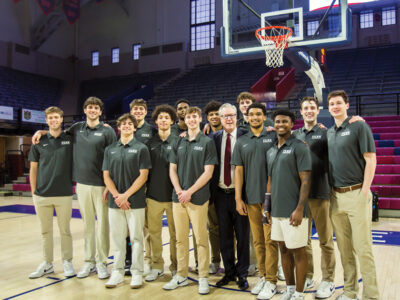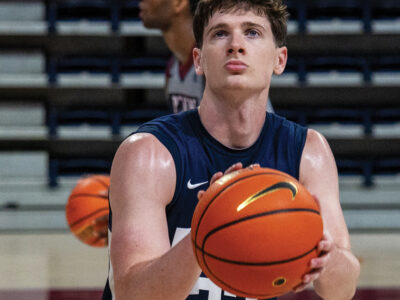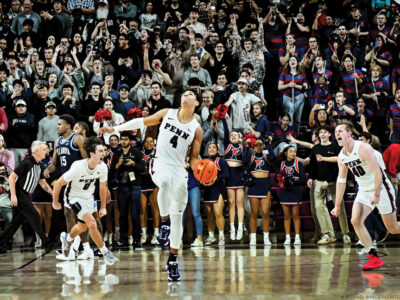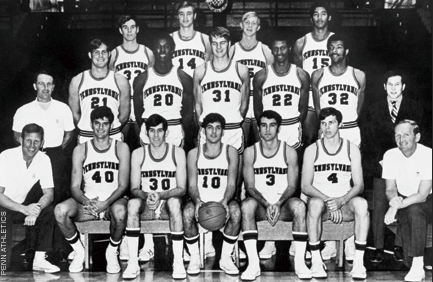
Penn’s 1970-71 men’s basketball team was arguably the very best the Ivy League will ever see—even if their 28-0 season did end with a baffling loss that stings even 40 years later.
By Dave Zeitlin
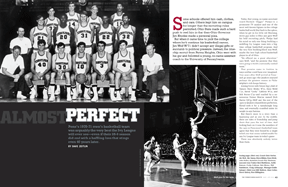
Some schools offered him cash, clothes, and cars. Others kept him on campus for longer than the recruiting rules permitted. Ohio State made such a hard push to reel him in that then-Ohio Governor Jim Rhodes made a personal plea.
But when it came time to pick the college where he’d continue his basketball career, Jim Wolf W’71 didn’t accept any illegal gifts or succumb to political pressure. Instead, the blue-chip recruit from Parma Heights, Ohio went with his gut and followed a young, no-name assistant coach to the University of Pennsylvania.
Today, that young, no-name assistant coach—Richard “Digger” Phelps—is a prominent TV analyst and one of the most well known figures in the college basketball world. But back in the 1960s, when he got in his little red Mustang, drove 450 miles to Ohio and gave Wolf his bold recruiting pitch, Phelps had his mind on only one thing: building a middling Ivy League team into a big-time college basketball program. And the very first building block was Wolf, maybe the best high school basketball player in all of Ohio.
“He offered me a great education,” says Wolf, “and the promise that they were going to build a nationally ranked team.”
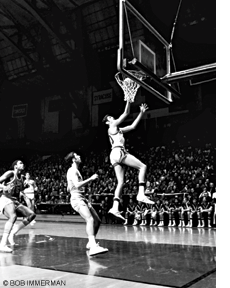
That promise came to fruition in ways neither could have ever imagined. Four years after Wolf arrived at Penn—and 40 years ago—the Quakers enjoyed perhaps the greatest season in Philadelphia’s rich hoops history.
Joining forces with future Big 5 Hall of Famers Steve Bilsky W’71, Dave Wohl C’71, David “Corky” Calhoun W’72, and Bob Morse C’72—and coached by a no-nonsense former Marine named Dick Harter Ed’53—Wolf and the rest of the 1970-71 Quakers chased down perfection, flirted with it for a tantalizingly long time, and eventually crumbled under its weight in epic fashion.
But there’s more to a story than a beginning and an end. In the middle, there are tales of friendship and jump shots that pass the test of time. And looking back on it now, the members of the 1970-71 Penn men’s basketball team agree that they were bound by a single belief, one that seems unfathomable for any Ivy League team in today’s game:
There was absolutely nobody better than them.
The Beginnings of Greatness
The season before Harter took over at Penn, the Quakers won 19 games and an Ivy League championship. But when longtime coach Jack McCloskey Ed’48 GEd’52 left following the successful 1965-66 campaign, so too did many of that team’s veteran players. The cupboard was bare, and Harter was essentially starting from scratch.
Harter’s first two seasons in charge were rough ones as the Quakers sputtered to an 11-14 record in 1966-67 and a 9-17 mark in 1967-68. But it didn’t take long for things to get better. And in a subtle twist, one of the people to thank for the quick transformation was an old baseball coach at Rider College named Tom Petroff.
Between stints as an assistant coach and the head coach at Penn, Harter spent one season running the Rider basketball program—the same place where Phelps played his college ball from 1960-63. Phelps had already graduated by the time Harter came to Rider, but Petroff knew both men very well. So when Harter got the job at Penn, Petroff all but demanded that he take Phelps with him. “He wouldn’t let me leave town unless I hired Digger,” says Harter.
Petroff saw what Harter and future Penn players would soon come to realize: Phelps was a go-getter and a rising coaching star. Immediately, Phelps asked Harter if he could recruit nationally, and with his head coach’s blessing—not to mention the budgetary support of then-athletic director Jerry Ford C’32 G’42—the young assistant coach began putting serious miles on his Mustang. He sold the Palestra, Big 5 doubleheaders, and a Wharton education, while pointing to the academic success of former basketball stars and Rhodes Scholars John Edgar Wideman C’63 Hon’86 and Princeton’s Bill Bradley. And he did it all with determination and gusto. “You just got a different feeling from Harter and Phelps as to what they wanted to do and what they wanted to accomplish,” says Wolf. “You felt that they were really going to do this.”
Wolf, who could have played basketball at just about any college in the country, was the first big score. “Him coming to Penn,” Harter says, “opened the door to get other players.” Some of those other players included high-school stars Jimmy Haney ChE’71 and sharpshooter John Koller C’71. But Haney dislocated his kneecap during his senior year of high school and was never the same, joining Koller in a reserve role for the duration of his time at Penn. Interestingly, it was a little-known recruit out of Long Island (Bilsky) and a football quarterback from New Jersey (Wohl) who made up the backbone of that 1971 class. “Steve and Dave were two guys that were not recruited nationally, but through sheer willpower, competitiveness, and hard work became the starting backcourt for the third-ranked team in the country,” says Alan Cotler W’72, a lawyer in Philadelphia and a junior reserve on the 1970-71 squad.
Indeed, when he got to Penn in the fall of 1967, Wohl was all set to begin his football career for the Quakers. But according to Bob Lyons, a Philadelphia sportswriter and the author of Palestra Pandemonium: A History of the Big 5, the Palestra, as it’s been known to do, butted in and changed the course of a life. “Shortly after arriving on campus, he took a walk down 33rd street, looking for a place to play [basketball],” Lyons says of Wohl. “He walked into the Palestra. He had never seen it before. No one was there. He looked around, and he fell in love with the place. Soon he started going every day and playing with the guys who were recruited like Bilsky. He decided these are the guys that he wanted to hang around with, and he told the football coaches he wanted to concentrate on basketball. One of them said to him, ‘You’re probably making the biggest mistake of your life.’ Then he goes on to be in basketball for four decades. I just love that story.”
When Bilsky, Wohl, and Wolf were sophomores in 1968-69 and playing on the varsity for the first time (freshmen were not eligible back then), the Quakers showed serious signs of improvement. They went 15-10 overall, 10-4 in the Ivy League. They were 1-3 in the Big 5, but their only win over a city rival was one of the most memorable in school history, as Penn stunned ninth-ranked Villanova, 32-30, in a slow-down game. In that win, Bilsky, now Penn’s director of athletics, hit the game-winning shot after the Quakers held the ball and ran the clock out for the final three-and-a-half minutes. “I set the screen and was open for the dump-off,” Wolf says, laughing. “But I was glad he took the shot.”
“More than anything else,” says Bilsky, reminiscing recently in his Weightman Hall office, “that kind of began the era in the 1970s when Penn became one of the best teams in the country. [Villanova] was nationally ranked. We were a non-entity. It became one of those famous Big 5 memories, and we didn’t lose a whole lot of games over the next three years.”
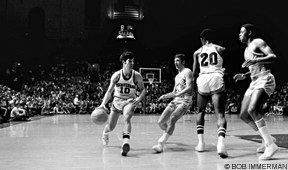

The Final Pieces of the Puzzle
It didn’t take long for the little-known forward from a Quaker family in rural Kennett Square, Pennsylvania, to bond with the highly touted guard from a working-class family outside Chicago. Both Morse (the Quaker) and Calhoun (the Chicago kid), after all, were soft-spoken guys who came to Penn for two reasons: to study and play basketball. And both turned out to be dynamos for the Quakers. “The pillars,” says Cotler, one of their classmates. “The two corners. I can’t think of two people better suited to represent a university on and off the court.”
That the two ballplayers were different only added to their appeal for Phelps, who vividly remembers driving out to Kennett Square with future college and NBA coach Jim Lynam, then an assistant at Saint Joseph’s University, to recruit Morse. “We watched him play one night and [Lynam] didn’t like him because he was a big man shooting jump shots,” says Phelps. “And I just said, ‘Wow, I like him becausehe’s a scorer and can shoot from the perimeter.’”
Morse wasn’t a very visible recruit, and he wanted to remain close to home, so for him Penn was an easy choice. With Calhoun, Phelps remembers really needing to sell Wharton to his father, who had to work a few jobs just to make ends meet. “That was a big catch for us,” Phelps says.
Both Morse and Calhoun would each go on to lengthy basketball careers after graduating from Penn, but when they arrived on campus in the fall of 1968 they really needed to lean on each other. “Corky came in as a high school All-American from suburban Chicago,” Morse says. “I played Class B high school basketball on a losing team down in Kennett Square. Although I scored a lot of points, I was not very well publicized. When I got to the Palestra, it was quite a rude awakening. It took a few months for me to come up to speed. Corky and I roomed together. At the time, neither one of us were highly verbal. We got along really well.”
While Morse and Calhoun were the linchpins of the class that followed Bilsky, Wohl, and Wolf’s group, Cotler was another big-time recruit that year. Like Wolf, he was wooed in all different ways. Cotler, who is Jewish, got letters from Jewish lawyers in Atlanta urging him go to the University of Georgia. The coaches at George Washington University set up a date for him (which, he says, was a bomb). Jim Valvano went to Long Island with instructions to pick from one of two players, and the legendary coach chose to recruit Cotler over a guy by the name of Julius Erving. (Valvano joked about that “mess-up” on the David Letterman show, which you can find on YouTube.)
But in the end, Cotler appreciated that Harter or Phelps didn’t do anything over the top in the recruiting process. When visiting Penn, the Long Island recruit was simply told to take the train to 30th Street Station, ask for directions and look for Bilsky, who would give him a tour. “What I liked about Penn is they treated me like a regular guy,” Cotler says. And when Duke offered him a scholarship, Cotler got a call from Phelps the very next day to lasso him in. “You couldn’t say no to Digger,” he says.
For Cotler and the other members of the Class of 1972, Phelps was almost larger than life. On the very first day of practice in 1968, Phelps, who also coached the freshmen team, gathered the Quaker newcomers—Morse, Calhoun, Cotler, and Philly guards Ron Billingslea C’72 and Billy Walters W’72—at the center of the Palestra floor. What he said next left an indelible mark on the youngsters. “He pointed an index finger at each of our chests,” Cotler recalls, “and said, ‘I just want you guys to know one thing. You’re at Penn for one reason, and that’s to beat the Tigers.’”
Penn did a lot more than just beat hated Princeton. That 1968-69 freshman team went undefeated, and when they joined forces with Bilsky, Wohl, and Wolf on the varsity the following season, the Quakers really took off, rolling to a 25-2 record and a 14-0 mark in Ivy League play. Perhaps most impressive was the team’s perfect 4-0 Big 5 record in 1969-70, because for so long the Quakers had been viewed as the lightweights of the city.
“I remember my first or second year, we were playing a Big 5 game against Villanova and there was a sign up that said, ‘Big 4 and Penn,’” says Phelps. “I never forgot that sign. When those guys had the year they had and when we won the Big 5, I turned to [Philadelphia Inquirer sportswriter] Frank Dolson [W’54], and I said, ‘Do you remember that sign from a few years ago? Yeah, they were right. It is the Big 4—and Penn.’”
In other words: The Quakers were in a class of their own.
The Road to Perfection
The 1969-70 season was one of the greatest ones in Penn basketball history. But the way it ended—with a surprising 79-69 loss to Calvin Murphy and Niagara in the first round of the NCAA tournament—left a bitter taste in everyone’s mouth. Beyond that, Phelps left following the season to accept the head-coach position at Fordham (where he stayed for one year before coaching for more than two decades at Notre Dame).
Nevertheless, with every significant player returning, the pieces were in place to turn the 1970-71 campaign into a special one. And Harter knew anything short of a trip to the national finals at the Astrodome would be a disappointment. “From the very first day of practice, Coach Harter said, ‘We’re going to Houston,’” says Cotler. “We never lost sight of the fact that we were there to win a national championship.”
Those lofty goals fit the persona of Harter, who was a perfectionist in every way. He stressed team defense, built a machine-like offense, and ran brutally tough practices. “His practices were tough but fair,” says Wolf. “He required an awful lot. Sometimes we thought he was a Marine drill sergeant out there.”
No one bought into that hard-working mentality as much as Wohl, who was so serious that his teammates would sometimes try to make him laugh. But he was always the player who finished first when the team ran up and down the Franklin Field steps. “Dave was the serious guy who would get on other guys to make sure they were working hard,” says Cotler.
Wohl’s partner in the backcourt was more light-hearted and, says Cotler, the one who saw life “through the lens of humor.” But Bilsky was just as dedicated to his craft. Wolf remembers a game during their sophomore year when La Salle’s Roland Taylor stripped the ball from Bilsky with an incredible amount of force. “Steve, after that, was just going to control the basketball,” Wolf says. “No one took it from him. He controlled the offense.”
While Wohl was more of a scorer, averaging 15.3 points per game, the 5-foot-11 Bilsky was the engine that made the Quakers purr. And both were just about automatic from the free-throw line, where they each shot 84 percent. The combination was deadly, and the main reason it was impossible during that 1970-71 season for teams to come back on the Quakers. “I would not call us a flashy team at all,” says Wolf, who wasn’t a big scorer himself but a valuable interior defender. “With 10 minutes left in the game, if we had a 10-point lead, Stevie and Dave would just control the ball, dribble, and make free throws … We were very famous, from my understanding, because the bettors hated us. A lot of times when we were 15-point favorites, we would win by 14.”
Well, sometimes the Quakers blew the doors off teams. During one Palestra weekend when Harvard and Dartmouth came to town, Penn scored over 100 points in back-to-back games. And in routs like those, the Quakers were able to show off their deep bench, a unit dubbed the “Earthquakers” because of their ability to come into the game and shake things up. In fact, some say the five guys who made up that group—Koller, Cotler, Billingslea, and sophomores Phil Hankinson W’73 and Craig Littlepage W’73—could have made a very good Division I team on their own. “We were very competitive,” Cotler says. “We had a little competition between the first five and the second five in practices. After that, we were all one team.”
And they were one team that just kept on winning, no matter who they played, no matter where the game was held, no matter which player led the team in scoring and which one had to sit on the bench because of foul trouble. “Any time, any place, any conditions” was Harter’s motto, and the loaded Quakers took that to heart, cruising to an astounding 26-0 record in the regular season while ascending to a No. 3 national ranking, its highest in program history. With two games still left on its schedule, Penn won the Ivy League championship outright with a 93-63 romp over Yale on February 27, booking its ticket to the NCAA tournament.

Not every win was easy, though. Sometimes they needed a clutch shot—and when they did, it was Calhoun who usually came to the rescue. Calhoun, who came to Penn at 6-foot-4 before sprouting to 6-7, was the team’s most versatile player. The future first-round NBA draft pick could have scored more if the team needed him to but instead averaged a modest 10.1 points per game, while leading the team in rebounds with 8.6 boards per contest. But on January 28, 1971, he delivered maybe the biggest shot of the year when his 22-foot jumper against Princeton capped a furious Penn comeback and sent the game into overtime, where the Quakers eventually won, 66-62. Earlier in the season, the swingman hit a shot that gave Penn a 65-64 lead over Ohio State with 1:27 to go. The Quakers beat the Buckeyes, 71-64, in Columbus, Ohio that night.
The reason Penn did not need too many other last-minute shots to secure victory was in large part due to Morse, who was able to make baskets at any point in the game, from anywhere on the floor. “We used to call Bobby Morse’s 30-foot shots layups,” says Ed Spiegel, Penn’s student-manager from 1968-1971. “If you didn’t put a hand in his face, he would kill you.” Morse led the team in scoring that season with 15.4 points per game and shot a blistering 47.2 percent from the field. And while he had many huge offensive nights, he saved his best for last. In their first game of the NCAA tournament, the Quakers drew a Duquesne squad that featured identical 6-foot-10 twins Garry and Barry Nelson. Instead of trying to battle them inside, the 6-foot-8 Morse stepped back and began to drill long jump shots, scoring 20 of his 24 points in the first half to lead Penn to a gutsy 70-65 win. In the very next round, Morse dropped in 28 as Penn beat South Carolina, 85-75, for its 28th straight victory.
If their No. 3 national ranking wasn’t enough, those two victories proved to everyone that the Quakers could play with any team in the country. “I cannot remember a more hostile environment than when we played Duquesne in West Virginia with all of Duquesne’s fans roaring,” Cotler says. “It was really courageous that our guys were able to withstand all of that adversity to beat an unbelievably good team. After that, we passed the test that we weren’t just some Ivy League fluke. That, I thought, was something pretty remarkable.”
And just like that, it all came crashing down.
The Not-so-Grand Finale
The only way to explain Penn’s final game of the 1970-71 season is to say that it can’t be explained.
Oh sure, the players and coaches have tried to figure out what happened, how a perfect season could end so imperfectly. They’ve tried to dissect the Eastern Regional final against a Villanova team they had beaten by eight points earlier in the season. But the more they try to figure things out, the more cloudy things become. And in the end, all they are left with are the bitter memories of an astonishingly lopsided 90-47 defeat to the rival Wildcats, a result that dashed their title dreams.
“Anyone can lose a game,” says Bilsky. “Anyone can have a bad game and get killed. But to play a team you had beaten three straight years and to lose so badly makes you start wondering what happened.”
Essentially what happened was that Villanova, a very strong team in its own right, played a flawless first half and took the Quakers out of the game from the start. And the steep uphill climb was just too much for a Penn squad that was not used to coming back. From there, things just snowballed. “We were very, very consistent and that maybe worked against us in the last game against Villanova,” says Harter, who left Penn after the season to take the head-coaching job at the University of Oregon. “We very rarely trailed.”
Spiegel, the manager, remembers waking up at the crack of dawn in the Raleigh, North Carolina hotel the team was staying at and thinking something was off. “We were playing at 11 a.m. and we got up really early to eat breakfast,” he says. “And I said to Ron [Billingslea], ‘We seem really flat.’ Going into the game, we were just off-kilter.”
But even if there were a few ominous warning signs, Penn had all the confidence that a 28-0 team should have. In fact, the Quakers were so sure they’d be advancing that they booked a flight from Raleigh to Houston, instead of back to Philadelphia. When they had to get a new flight to Philly, they found themselves on the same plane as the ’Nova players, walking past them as they boarded. “They were very gracious, but it seemed like there were thousands of Villanova fans waiting for them at the airport,” says Bilsky. “We got some taunts there. It was kind of like a nightmare that got worse as the day progressed.”
Sure enough, things got even worse from there. Just like their season, the team bus unexpectedly broke down on the trip back to campus from the airport. And as the Quakers waited a couple more hours for a new bus to retrieve them, visions of the 90-47 loss dominated their thoughts. “That game,” says Wolf, “is a thorn in the side of every one of us. And it will always be a thorn.”
These days, the ex-Quakers are reminded of it whenever something truly unpredictable happens. Cotler, a New York Giants fan, said he started talking to friends about the Giants blowing a three-touchdown lead in the final seven-and-a-half minutes and losing to the Eagles this past season. And he told them this: “What I learned back on that day in 1971 is that sometimes in life you can’t explain things,” he says. “Sometimes things just happen for reasons nobody can figure out completely. Ask the New York Giants what happened to them against the Eagles and no one can pinpoint it. For us, we were one game away from finally going to Houston. It was everything we were talking about since Day One. And just about every single thing that could go wrong went wrong. And for Villanova, everything that could go right went right.”
For Harter, it was another football game that brought back memories of the loss to Villanova as he watched his coaching friend Bill Belichick and the New England Patriots lose a playoff game to a New York Jets team they had beaten by 42 points the previous month. But in reality, the old coach’s 80-year-old brain doesn’t need to be prodded very much when it comes to the final game he coached at Penn.
“I’m sure there’s never a day,” Harter says, “where I don’t think about it.”
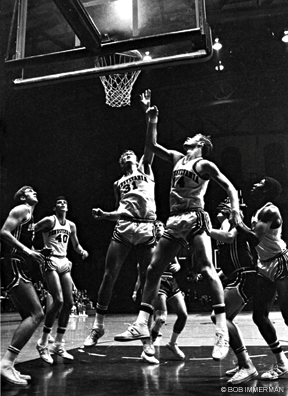
The Lasting Legacy
It’s been 40 years since Penn’s brush with perfection, and as time passes by the story only gets more improbable. At its core, Penn was still an Ivy League team. The players studied hard. They played word games on the bus. They didn’t have the amenities and resources of bigger, more athletics-oriented schools. Once, on a road trip to Cornell, the team bus got stuck in a snow bank about 45 minutes from Ithaca, and as the players braved the freezing temperatures to push the 15-ton vehicle back onto the road, Spiegel remembers Bilsky commenting, “I wonder if UCLA travels this way.”
The Quakers didn’t have the same kind of fame or mass appeal of John Wooden’s legendary UCLA Bruins, but they did have a loyal fan base in Philadelphia. They sold out the Palestra just about every time they played, and there was at least one time when students took a break from a Vietnam war protest at College Hall to watch a couple of hours of hoops. “It was a campus unifier, it really was,” Spiegel says.
To this day, the team still brings people together. In his current job as Penn’s athletic director, Bilsky often sees a glimpse of his old self, in photos and trophy cases. But when he’s not on campus, the 1970-71 team still comes up in plenty of conversations. Even Spiegel, who never suited up, feels a deep connection to those Quakers. At a Union League dinner not long ago, a diehard Penn fan came up to him and asked, “Weren’t you the manager of the 1971 basketball team?” Surprised that he was recognized four decades later, Spiegel, who today is a pediatrician, told Governor Ed Rendell C’65 Hon’00 that, why yes, he was indeed.
It’s also a testament to just how good that team was that many of the players achieved more athletic success upon graduating. Wohl was selected by the Philadelphia 76ers in the third round of the 1971 NBA draft, played seven years in the NBA and has remained in professional basketball in coaching and management [“Alumni Profiles,” Mar|Apr 2007]. Calhoun was the fourth overall pick in the 1972 draft and played in the NBA throughout the 1970s. Morse became one of the all-time great European league ballplayers. Hankinson, who averaged 9.2 points per game off the bench in 1970-71 before evolving into an all-time Quaker great, played two seasons for the Boston Celtics before a knee injury cut short his playing career (and, tragically, triggered the depression that his father said may have caused his suicide in 1996). Wolf and Haney followed Harter to the University of Oregon as assistant coaches, and Haney, who later became the Ducks head coach, is now the executive director of the National Association of Basketball Coaches. And Bilsky and Littlepage, a former Penn coach and the current AD at the University of Virginia, both went on to successful careers in athletic administration.
But even as all of those players moved on in their lives, the Quakers remained a force for the rest of the decade. Chuck Daly replaced Harter as coach in 1971-72, inheriting a team that boasted Morse and Calhoun and taking them back to the regional finals. The future Pistons coach ended up winning 125 games through six seasons at Penn before ceding to Bob Weinhauer, who accomplished what his predecessors could not in guiding the Quakers to the 1979 Final Four. And while some people think the 1978-79 team overshadows the 1970-71 squad, there’s no denying that it was the accomplishments of the earlier group that began Penn on its road to success. “That was the very best team in the Ivy League,” Harter says of his last group at Penn. “Flat-out, no doubt about it.”
Even though the Quakers were still dominant for years after he moved on to Oregon, Harter left because he could see the writing on the wall. When he was told his team might have to stay in dormitories rather than hotels in the future, he realized that it would become harder for Ivy League schools to attract big-time players. And as his extensive and illustrious coaching career [“Alumni Profiles,” May|June 2009] took him from Oregon to NBA cities around the country—and the Quakers slowly fell from national prominence—he wistfully mourned the days when Penn was a powerhouse and fans packed the Palestra for Big 5 doubleheaders. “I wish Penn still played big-time sports,” Harter, who only last year retired after 57 years of coaching, says today.
To be fair, Penn’s basketball program still has a strong following, and, in its best years, has the potential to win a game or two in the NCAA tournament. But just about every player from the 1970-71 team—Bilsky being the lone exception—considers it virtually impossible for the Quakers to ever repeat the success they had. Too much has changed. “Do I think it can be done again? It would be quite difficult,” admits Penn’s current head basketball coach Jerome Allen W’09, who wasn’t even alive in 1971. “It’s a different era. But every team in every conference strives for excellence. Those guys who had an undefeated mark in the regular season—it says a lot about their approach to the game, their concentration and their commitment to one another. That’s why it hasn’t been done in so long. It’s hard to duplicate.”
So through this decade and the next, players and coaches in all sports, in all countries, will start a season hoping to win every game they play. Sports can be unpredictable and fickle, so they can dream. But aiming for perfection and achieving perfection are two very different things. Forty years ago, a group of Ivy League kids nearly accomplished the latter.
They were almost perfect.
“We shouldn’t have lost,” says Wolf, the kid who came from Ohio because he believed. “We were that good.”
Dave Zeitlin C’03 writes frequently for the Gazette and oversees the magazine’s sports blog.


